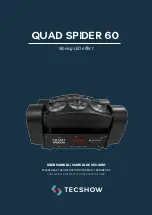3-3
To load a telemetry waveform the user must connect to the serial port, type the command LWTEL, go to
the FILE drop down menu and select SEND FILE, and select the waveform to be loaded.
3.1.2.9
Auxiliary Telemetry
Auxiliary telemetry is very similar to pressure telemetry. The difference being that instead of measuring
pressure, the delay is based on an analog signal supplied by an external sensor. The auxiliary analog signal
range is 0 – 5 Vdc, with the two reply pulses scaled for a 100mS delay at 0 volts input, and a 1.000 second
delay at 5.00 Vdc input.
3.1.2.10
Receive Sensitivity
The receive sensitivity of the 4380 can be switched between 100 and 200 microvolts. The reduced
sensitivity setting (200 microvolts) is useful when tracking at short ranges and in high multipath
environments.
3.1.2.11
Battery Voltage and Charge Status
The 4380 is internally powered by a pair of Lithium ION battery backs. An on-board charge management
circuit monitors the batteries and controls the charge profile. Querying the beacon will report back the
battery pack voltage and charge status. The beacon will report a charging fault if the temperature inside
the tube is outside of the allowable range (0 – 45 degrees C).
The Lithium ION batteries in the beacon have an internal protection circuit built in. This circuit prevents
the batteries from being over charged and from being deep discharged. When the protection circuit
senses the cell voltage is below the lower cutoff threshold, it will disconnect the cells automatically.
3.1.2.12
Turnaround Time
Turnaround time is the time delay between the beacon detecting the interrogate pulse and the beacon
sending the reply pulse when the beacon is acting as a transponder. It should be noted that short
turnaround times make it impossible to track a beacon at close ranges. Longer turnaround time (~100mS)
allows the topside to track down to a range of essentially zero meters.
3.1.2.13
Responder Lockout
The responder lockout time sets the maximum rate that the responder can be keyed. When operating as
a responder in high electrical noise environments, longer responder lockout times are desirable because
they reduce the number of false triggers seen by the responder. If the Responder Lockout is set to less
than 1 second, it can interfere with the telemetry readings.
Summary of Contents for 4380 MULTIBEACON
Page 14: ......
Page 20: ......
Page 34: ......


















